How To Choose Skate Apparel | Skater Aesthetic Over the Decades
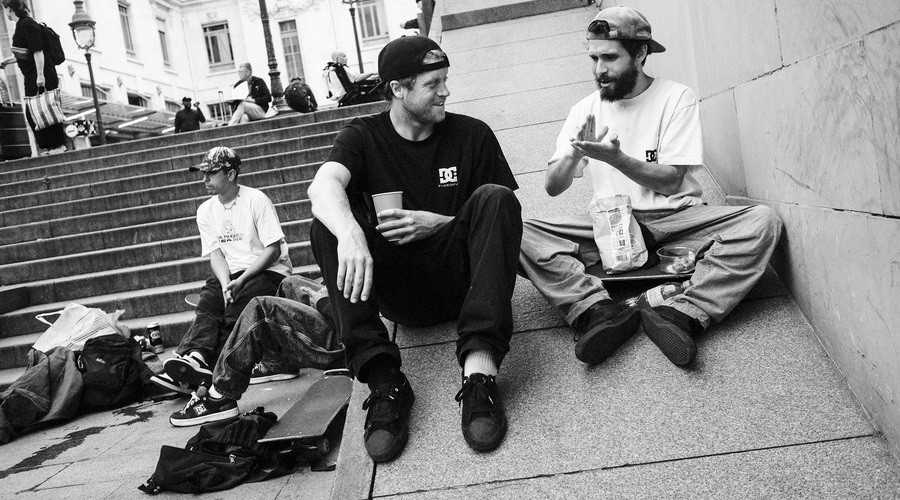
Clothing is part of the cultural identity of skateboarding, and while it has varied over the decades, certain factors that go into choosing the best clothing for the job have remained constant, like durability, comfort, and a tough, functional aesthetic. What clothes do skaters wear? The skater look, aka what skateboarders wear is deeply rooted in streetwear, blending style with performance. Skateboard fashion, also known as skateboard style and the skater aesthetic is about more than just the threads - it represents the counterculture spirit of skateboarding itself.
To dress like a skater, think relaxed fits, hardy materials that can withstand abuse, and versatile layers that allow for movement. Oversized tees, baggy cargos or chinos, and chunky skate shoes are classic skater fits and staples of the skater dress style, so this is the first step towards how to dress like a skater. The clothes prioritize mobility on the board but also channel an urban, laid-back vibe off it. Skate brands put their own spin on timeless streetwear pieces, delivering the function skaters need with a unique flair. What do skaters wear? Apparel that lets them skate hard while still looking stylish.
Skater Clothes History
History’s most iconic skateboarders have been characterized by out-of-the-box thinking and a non-conformist attitude, and as the sport has evolved, so has the style.
The following section covers the evolution of skate style through the decades.
‘50s Skater Style
The ‘50s may have seen the birth of skateboarding, but at the time it didn’t have a style of its own: that came later, as skaters got inspired by the vibes of the era. ‘50s Style Skater Dress for men channels hot rod and rockabilly vibes. For a modern take on 50s style, skater-style men can rock slim-fitting jeans or cuffed chinos with a vintage tee or bowling shirt.
‘70s Skater Style
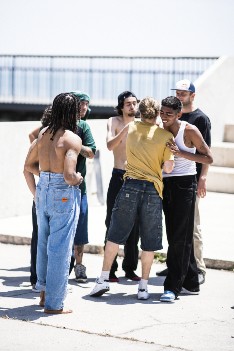
In this era, before video brought skate culture to the mainstream, male skater fashion didn’t have a distinct style. Skaters wore the same clothing that everyone else wore; short shorts, tanks, and knee and elbow pads.
In the last half of this decade, the famous Zephyr skate team, known as the Z-Boys, changed skateboarding with their disruptive style and counterculture clothing.
The Z-Boys wore long pants and plaid shirts for more protection. However, on warmer days, some skaters would go shirtless with shorts to stay cool during intense pool riding sessions.
Tony Alva, one of the most successful and popular skaters of the era, was one of the first skaters to use his image to sell skateboards. He promoted his style to the masses and helped define the look of an entire culture.
‘80s Skater Style
Skateboarding, particularly vert skating, was wildly popular until the mid-1980s 1980s until street skating became prominent. High-top skate shoes marked the era, adopted in both skateboard disciplines.
Shorts began to get a little longer but still remained above the knee. Patterns and bold colours lit up parks as skaters expressed their own sense of style.
‘90s Skater Style
As skateboarding entered the 90s, it began to part ways from mainstream fashion as skate style clothing got baggier. Oversized t-shirts were paired with baggy pants that sagged below the waistline. Baggy shorts followed suit and extended below the knee.
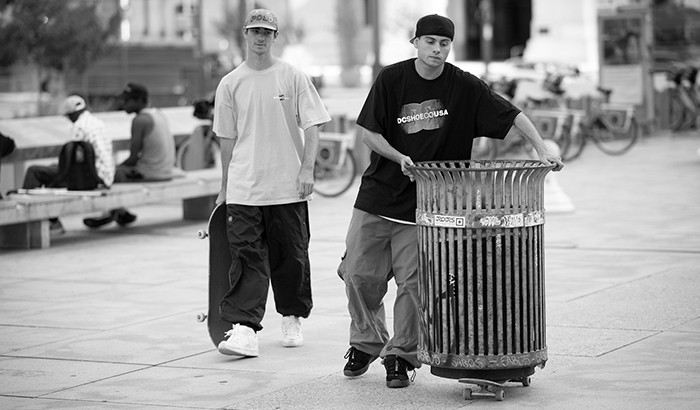
By the mid-90s, tighter clothing and dark colours started to make their appearance in subcultures, countering the rise in the popularity of bagginess and bright colours of the 80s. This new trend paved the way for the more tailored look which gained popularity in the following decade.
Vulcs and slim low-tops made a comeback while shoe brands began to battle for who could put the most tech into their shoes, like the iconic DC Stevie Williams Pro Model.
2000s Skater Style
Skate wear continued to evolve in Y2K with a more tailored look. This look included slim pants and the occasional polo shirt, paired with low-top skate shoes and a flat-brimmed cap.
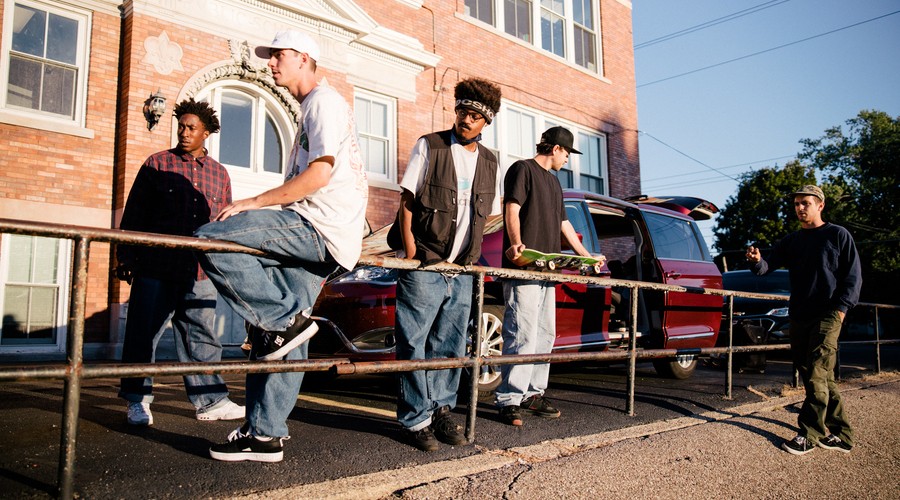
By the end of the 2000s, this punk rock-inspired style had a huge effect on the industry as shoe companies began to phase out their puffy shoes and skate apparel brands focused on slim-fitting clothing. And, once again, mainstream fashion soon followed suit. Huge brands like Levi’s began making skinny jeans again and low-profile vulcs became the order of the day.
In the 2010s, skate style became a little less extreme. The pants weren’t quite as skinny and the shoes were neither too puffy nor too slim, but skate styles remained ahead of the curve and continued to influence mainstream and high-fashion brands.
Skateboarder Style Today
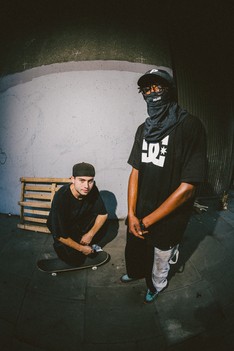
As skate fashion of the 2000s became mainstream, an undercurrent of skaters began to break the mould, reconnecting to the anti-conformist ideals at the core of the sport. What they created was a hybrid of styles from generations past.
The baggy style of the ‘90s has returned with modern deckhand beanies and oversized t-shirts. Iconic logos and large screen prints continue to be anchored to the culture with low-cut skate shoes.
What Is Skater Style?
As skate fashion of the 2000s became mainstream, an undercurrent of skaters began to break the mould, reconnecting to the anti-conformist ideals at the core of the sport. What they created was a hybrid of styles from generations past.
The baggy style of the ‘90s has returned with modern deckhand beanies and oversized t-shirts. Iconic logos and large screen-prints continue to be anchored to the culture with low-cut skate shoes. What Is Skater Style? Skate style may have varied throughout the decades, but two common threads have tied them all together; casual and functional.
- Casual in that we see collared shirts and pleated pants with a touch of anti-conformism, like skate shoes or a flat-brimmed cap.
- Functional in the cuts and materials that promote durability and range of movement, such as high denier and elastane thread.
Which Skate Clothes To Choose From?
Skateboard outfits all start with the right pair of shoes, and then you add in the pieces that work together as a whole. The following section explores these elements, working from the ground up.
Skateboard Shoes and Socks
Skate shoes come in three different heights:
- Low-cut
- Mid
- High-top
Slip-ons are laceless low-top shoes in a class of their own. Originally developed in the 1960s, modern low-profile slip-ons offer an excellent board feel and are now offered by all the major skate brands.
Skate shoes can be made of a variety of different materials which have an impact on durability, weight, comfort, and performance. Ventilation, soles, tongues, and even lace eyelets have all been designed for optimum performance in skateboarding.
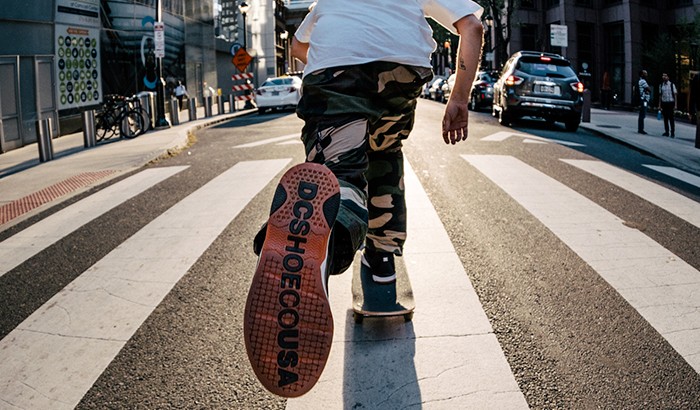
Skate shoes are always worn with a pair of socks to provide cushioning. High socks provide extra cushioning around the ankles and shins which benefit from extra protection when skateboarding.
For more information on skate shoes, be sure to read our dedicated article on “How to Choose Skate Shoes”.”.
Skate Pants and Shorts
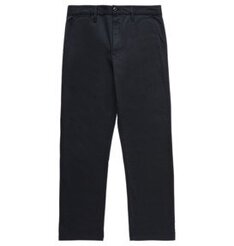
Some skaters wear pants because they provide an extra layer of protection for the knees and shins. Many skate pants are high denier – meaning high thread thickness – to provide durability, and often use a certain proportion of elastane to help pants stretch when crouching low for an ollie.
Skaters who opt to wear shorts do so for added ventilation and ease of movement. They’ll often protect their shins with a pair of high socks. Traditional skater shorts are baggy and knee-length. Today's skater style dress code has tighter shorts that stop just above the knee.
Skate Hoodies
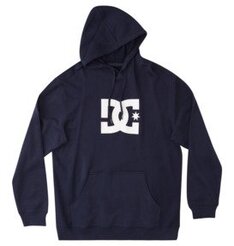
Hoodies have been a staple in skater style since their widespread adoption into the culture in the 1990s. Hoodies can either be:
- Zip-up hoodies with two pockets at the waist hem
- Pullover hoodies with a kangaroo-style pocket at the waist hem
One thing is for sure, the hoodie is not going out of style anytime soon. Pull one on on cold days and push a little longer.
Iconic Skateboarder T-Shirts
Certain logos, like the DC star, have become iconic in skateboard culture. These logos symbolize belonging to skate culture.
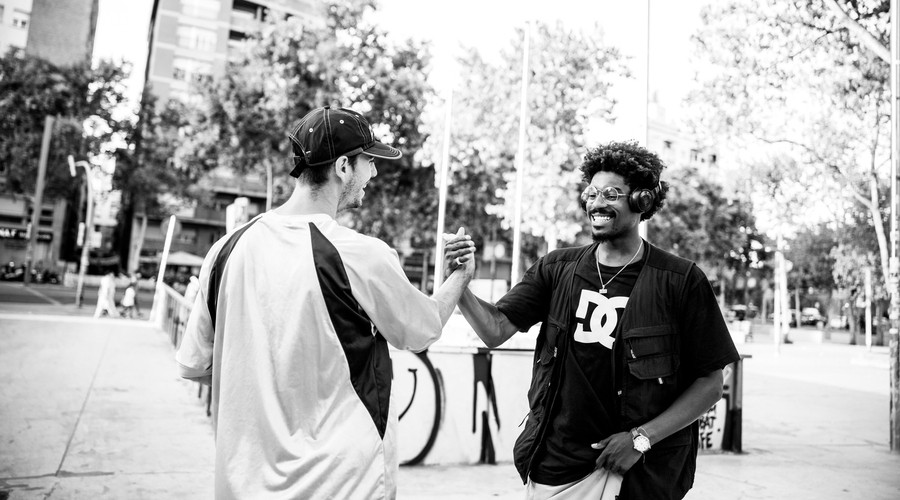
Skate Hats and Beanies
All skater outfits need a hat or a beanie.
Caps can vary in styles including, but not limited to:
- 6-panel Flexfit® or snap-back hats
- Trucker hats
- 5-panel structured baseball-style hats
- Low-profile, unstructured hats (often called “dad hats”)
- Bucket hats
Beanies can be left long or made low-profile by rolling up the cuff. Today’s style is beanies sitting atop the head rolled up and above the ears.
Style has played an important role in the culture since the very beginning of skateboarding. Range of movement, durability, comfort, and protection all play a role in choosing the right clothing to create your unique skater style.


